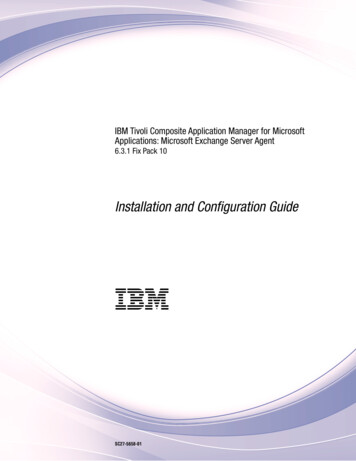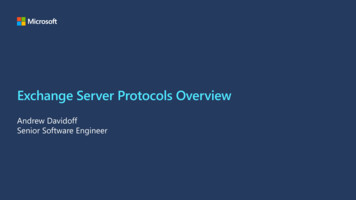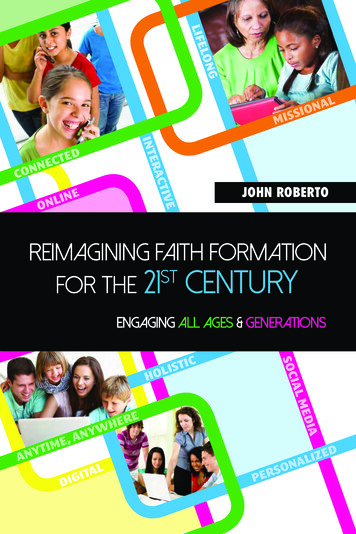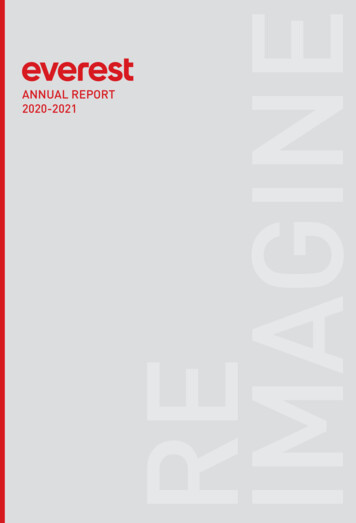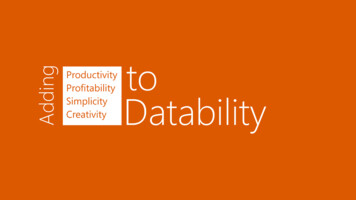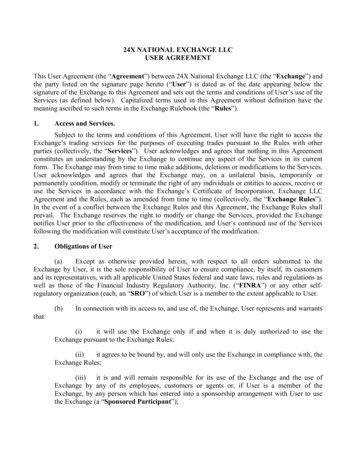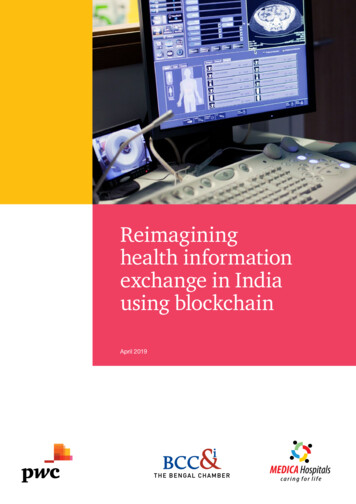
Transcription
Reimagininghealth informationexchange in Indiausing blockchainApril 2019
ContentsForeword. 3Executive summary. 41.Current state of health information exchange in India. 52.Blockchain: An introduction. 83.Use cases of blockchain in healthcare.104.Reimagining health information exchange using blockchain.115.Key considerations for blockchain adoption. 206.Call to action: Recommendations for the industry. 24
ForewordThe healthcare industry in India has long been facedwith multiple challenges: making healthcare affordable,availability of sufficient healthcare resources and belowpar patient experience.As the Indian healthcare ecosystem considers theadoption of blockchain, it is imperative to establish acountry-wide information exchange of electronic healthrecords (EHRs) at the very outset.Technological advancement in recent years has ledto increased adoption of information technology andconnected the operational technology of healthcareproviders globally. It has also increased adoption ofhome-care and fitness-tracking devices by patients andenabled healthcare insurers to mass-personalise theirproducts. At the same time, social media has increasedawareness of the high standards of technology-ledhealthcare and patient experience across the world,raising the expectations of all these stakeholders from theIndian healthcare sector.On the one hand, distributed and connected systemshave the potential to open new avenues of masspersonalised healthcare, on the other, they raisequestions around data privacy, security, inconsistencyand incompleteness.Seamless sharing of information between providers willensure faster and more accurate diagnoses and moreeffective treatments for patients. It will also increase theoverall ability of providers to make care delivery costeffective and improve the overall patient experience.The use of unique digital signatures to authenticateinformation makes blockchain a secure encodedtechnology, and it could be the answer to the Indianhealthcare industry’s legacy challenges. Blockchaincan allow stakeholders in the healthcare ecosystem toshare patient, treatment and clinical information withoutcompromising on security by ensuring information originas well as change tracking.There are two perspectives on reimagining healthinformation exchange in India: one calls for secureenabling technology, while the other calls forstandardisation through regulation. For the former, Indianeeds to look at global trends and evaluate emergingtechnologies such as blockchain. In the latter case,enabling standardised and secure health informationexchange between healthcare providers and adjacentindustries such as healthcare, insurance and pharmais an important task for the regulator. With the Indiangovernment having framed policies and standards onEHRs, the first steps in this direction have been taken.Abhijit MajumdarPartner and Technology Strategy LeaderPwC India3 PwC Reimagining health information exchange in India using blockchain
Executive summaryThe workflows of healthcare organisations are complex,interdependent and data intensive, with informationbeing generated by the various stakeholders, includingpatients, payers and providers. Technology has helpedthe healthcare ecosystem to optimise these complexworkflows by connecting the various stakeholders andproviding real-time information that helps in deliveringenhanced patient care. Historically, the Indian healthcareindustry has been slow to adopt technology. Thus, theecosystem comprises disjointed information systemsthat lack trust, data security, standardisation andinteroperability, all of which are imperative for seamlesshealth information exchange. The Indian healthcareindustry is currently on the cusp of a transition withthe launch of the ambitious Ayushman Bharat Yojanaand its aim to achieve the World Health Organization’s(WHO) goal of Universal Health Coverage (UHC) by2022. In order to provide quality care to the scheme’sbeneficiaries, the country needs to leverage reliabletechnology that can help in accessing health informationcaptured across various healthcare providers andimproving areas such as tracking and detecting fraudsin the payer management cycle and drug supply chain.Large-scale national healthcare initiatives would need atechnology solution that encourages active participationof all stakeholders in order to generate and exchangemeaningful health information in a secure and timelymanner. The National Health Policy (NHP), 2017, hasidentified the goals for health information management,such as building a district-level health system informationdatabase, and establishing a federated integrated healthinformation architecture, health information exchange andnational health information network by 2025.1Blockchain is an emerging technology that can helporganisations across various industries, includinghealthcare, to redefine the framework for informationgeneration and exchange. It offers the potential totransform some of the key areas of healthcare byincreasing interoperability and process optimisation, andmaintaining the overall security and privacy of data byincreasing trust among stakeholders. Globally, healthcareorganisations have started reaping the benefits ofblockchain technology in terms of its various applications,such as in health data management, health informationexchange, provider credentialing and accreditation, andpharmaceutical supply chain management. The Indianhealthcare industry is slowly catching up.Adoption of blockchain technology by the Indianhealthcare industry will happen over a period of time asthe effectiveness and sustainability of each use caseare currently under research and development. At thesame time, healthcare organisations need to undertakethe necessary planning activities before entering intoblockchain-based partnerships and programmes. Asmajor transformations begin with small steps, this paperbegins by exploring the current state of health datamanagement and information exchange in India. It thenintroduces the concept of blockchain technology andhow it can be leveraged to establish a well-connectedhealthcare ecosystem through health informationexchange. Next, it explores the current challenges andkey success factors for the adoption of blockchain in theIndian healthcare ecosystem. The paper concludes withour insights and recommendations on how blockchaincan be adopted by the Indian healthcare ecosystem.1. Ministry of Health and Family Welfare, Government of India. (2017). National Health Policy 2017. Retrieved from 1489753121.pdf4 PwC Reimagining health information exchange in India using blockchain
Current state of healthinformation exchange in IndiaThe Indian healthcare ecosystem consists of seven keystakeholders – patient, provider, payer, pharma, medicaltechnology, technology vendors and suppliers, and thegovernment and healthcare regulator. These stakeholdersinteract with each other through a complex network ofinterdependent and data-intensive workflows to generatemeaningful health information. Technology has helpedthe healthcare ecosystem to optimise these complexworkflows by connecting the various stakeholders andproviding real-time information to deliver enhancedpatient care. As a result, the entire ecosystem movedfrom manual to digital media for the capture and storageof health information (e.g. medical records). Further,various platforms such as telemedicine and mobile healthapplications were developed to enhance connectivitybetween its stakeholders. The industry is currentlytransitioning from a manual to a digital care model whichallows remote monitoring.India has begun its journey towards achieving UHCby 2022 and has aligned NHP 2017 with this goal. Theambitious Pradhan Mantri Jan Aarogya Yojana (PMJAY),which was launched during Union Budget 2018–19, isa part of NHP 2017. It envisages two key components– establishing Health and Wellness Centres (HWCs)and a national health insurance programme under theNational Health Protection Scheme, recently renamed asPradhan Mantri Rashtriya Swasthya Suraksha Mission(PMRSSM).2 UHC aims to increase access to qualityhealthcare services at an affordable cost for all people,3while the PMRSSM aims to increase accessibility,availability and affordability of primary, secondary, andtertiary care health services in India.4 National healthcare01initiatives of this scale would need a technology solutionthat enables all stakeholders to generate and exchangemeaningful health information in a secure and timelymanner. Implementation of PMJAY and attaining the goalof UHC will require technology that links together thevarious HWCs spread across the country. Technologywill also serve as the backbone for building a nationallevel IT platform and facilitating beneficiary identification,strategic purchase of care services, disbursal of providerpayments, fraud detection and monitoring of thescheme.5 NHP 2017 has identified the goals for healthinformation management, such as ensuring a district-levelhealth system information database and establishingfederated integrated health information architecture,health information exchange and developing a nationalhealth information network by 2025.62. Lahariya, C. (June 2018). ‘Ayushman Bharat’ Program and Universal Health Coverage in India. Indian Pediatrics, 55:495-506. Retrievedfrom -506.htm3 World Health Organization. (24 January 2019). Universal health coverage (UHC). Retrieved from iversal-health-coverage-(uhc)4 Lahariya, C. (June 2018). ‘Ayushman Bharat’ Program and Universal Health Coverage in India. Indian Pediatrics, 55:495-506. Retrievedfrom -506.5 Ibid.6 Ministry of Health and Family Welfare, Government of India. (2017). National Health Policy 2017. Retrieved from 1489753121.pdf5 PwC Reimagining health information exchange in India using blockchain
Indian healthcare ecosystem and its stakeholdersMedical technologyTechnology vendorsand suppliers Medical devices andequipment Diagnostics Electronic medical records Hospital information system Lab information systemPharma Pharma manufactures Pharma suppliers Retail pharmacyGovernment andhealthcare regulatorPatientProvider HospitalsHealthcare centresSpecialist clinicsAYUSH clinicsDiagnostic labs6 PwC Reimagining health information exchange in India using blockchain Ministry of Health andFamily Welfare National Digital HealthAuthorityPayer Private health insuranceSocial health insuranceEmployee health insuranceThird-party administrator
The use of technology to tackle the anticipated rise inhealthcare information generation and exchange posesseveral challenges related to data identification, security,privacy, accessibility, and reliability.Key data-related challenges in the Indian healthcare ecosystemPatient identification01A key challenge is the unique identification ofpatients across the healthcare journey. Each careprovider in India uses different combinations ofpatient identification, making the entire processof unique identity inefficient and futile. NHP 2017suggests exploring the use of Aadhaar for uniquehealth identification for basic health services inthe country.7 However, in the current technologylandscape, identifying a patient with a Universal HealthIdentification (UHID) number across India is a challenge.Data ownership and duplication03Currently, patients don’t have ownership of theirmedical records, as the care provider retainscontrol over patient data and is reluctant to shareit with any other care provider in the healthcareecosystem. This leads to duplication of healthdata being generated for the same patient as s/hemoves from one provider to another.Data security and privacy05Provider-driven localised control of health dataand existing technology platforms for datasharing have rendered healthcare data prone tovarious forms of cyberattacks, data trespassingand data security breaches. In 2018, an Indianhospital was targeted by a ransomware attackthat locked out users and prevented them fromaccessing their data. The virus spread before itcould be detected and contained.Scattered and disjointed data02Meaningful health information comprises of two parts –patient identification information, which is captured frompatient demographics, and the patient’s health information.At the provider level, both of these are scattered acrossdifferent departments and information systems, making itdifficult to access and analyse collectively.Also, current health information systems operate in adisconnected fashion and there is no formal connectionamong the various healthcare stakeholders (e.g. payerand provider) for information exchange.Role of third party04The Indian healthcare ecosystem has relied onvarious third-party intermediaries (e.g. third-partyadministrators or TPAs) for health insurance claims andprocessing. These third parties add to the complexity,time and overall cost of healthcare.Data exchange06Lack of unified healthcare industry standards, noninteroperable information systems, and lack of healthdata exchange platforms make it difficult for healthpolicy planners to collect, analyse, and exchangemeaningful health information in a more secure andseamless manner.7. Ministry of Health and Family Welfare, Government of India. (2017). National Health Policy 2017. Retrieved from 1489753121.pdf7 PwC Reimagining health information exchange in India using blockchain
Blockchain: An introductionWhat is blockchain?02Blockchain is a distributed, shared and immutable digitalledger that keeps a record of all transactions that takeplace across a peer-to-peer network. It helps to improvethe overall business reach by cutting out intermediarieswhile offering greater transparency and traceability of thebusiness processes.It is a decentralised (stored in multiple places)record of transactions, also known as a ledger. It isdistributed among different entities (nodes) acrossa network who have access to copies of the record.Transactions are bundled together into a datablock, which undergoes encryption, resultingin a unique signature for each block knownas a hash.Participants add to this shared ledger byrecording information about transactions(information change), which are validated andaccepted by users based on a consensus.These blocks are then ordered sequentially intoa chain of blocks, with each block containing theprevious block’s hash, making it tamper proof.The blocks are immutable, as altering a single pieceof data would result in a different hash value, makingthe change evident to the blockchain’s users andresulting in the transaction being rejected.ValidationThe nodes validate the transaction and theuser’s status using known algorithmsSomeone requestsa transactionThe transactionis completeThe requested transaction isbroadcast to a peer-to-peernetwork consisting of nodesThe new block is then added tothe existing blockchain, in a waythat is permanent and unalterableA verified transaction can involvecryptocurrency, digital token,records, or other informationOnce verified, the transaction is combinedwith other transactions to create a newblock of data for the ledgerSource: PwC, ‘How blockchain works’ er-on-blockchain-infographic/)8 PwC Reimagining health information exchange in India using blockchain
Types of blockchainOn a broad level, blockchain is categorised as public,private and permissioned to correspond with the accesscontrol and visibility mechanisms that can be broadlyassigned through its prevailing frameworks. A publicblockchain is open and allows anyone to participate inthe network activities; private blockchains have ownercontrolled participation; and permissioned blockchainsare a mix of both (public and private) with highlycustomised read, write and access permissions. Thenature of access controls and visibility required for aspecific implementation would be influenced by:1. The business operating model2. Stakeholders and their corresponding bargainingpower in the business model3. The end users of the applicationGiven this framework and the complex nature ofhealthcare industry’s multiple stakeholder involvement,permissioned blockchains suit the healthcare industry.How blockchain can help the healthcare ecosystemOver the years, a provider-centred care delivery modelusing the current framework of existing technologieshas resulted in a lack of trust and transparency inthe healthcare ecosystem. This, along with issuessurrounding patient data privacy, security, and the fearof losing the competitor advantage by sharing datawith another provider in the healthcare ecosystem, hasaggravated some of the previously mentioned datarelated challenges. However, as the Indian healthcareindustry now transitions to a more patient-driven caredelivery model by introducing preventive healthcare andforming a close-knit ecosystem of patient-payer-provider,it is highly imperative to decentralise this model usingtrust-enabling technology.With its unique selling proposition of data security,blockchain is positioned as one of the key emergingtechnologies that can help in establishing a trust-basedhealthcare ecosystem by keeping the patient at the centreof all data generation and exchange. It has the potentialto redesign some of the key processes of the healthcareindustry by making them secure, transparent andefficient through accountable participation by all the keystakeholders. The seamless and secure generation andexchange of data over a blockchain-enabled technologyplatform can help improve the overall patient experience,health outcomes, and promote further researchand insights for policy planners to improve citizens’healthcare.Across the world, blockchain has begun gainingattention as a means to ensure and improve trust,accountability, and transparency in the current complexand interdependent workflows of the healthcare industry.Some healthcare organisations have already implementeda few of the key application use cases in the areas ofhealth data management, health information exchange,clinical trials management, tracking the pharmaceuticalsupply chain, health insurance claims management andhealthcare provider credentialing and accreditations.Blockchain has the ability to transform healthcare and make it more patient centric.It has the potential to digitise the entire patient lifecycle by creating immutablerecords across systems and letting bona fide stakeholders use those records digitally.Along this transformation journey, blockchain also has the potential to automate andimprove trust in healthcare delivery.Arijit ChakrabortiPartner, Technology Consulting, PwC India9 PwC Reimagining health information exchange in India using blockchain
Use cases of blockchain in healthcareGlobal use casesGlobally, blockchain has gained popularity in offeringsolutions for health data management and healthinformation exchange. Estonia’s adoption of blockchainbased electronic health records (EHRs) is worthmentioning. When Estonia gained independence fromthe Soviet Union in 1991, it leveraged technology in ashort period of time to empower its citizens and improveits various public sectors, including healthcare. TheEstonian National Health Information System has beenusing blockchain-enabled e-health record solutions and100%electronic billingin healthcare03a health information exchange platform. This ensuresdata integrity, mitigates internal data threats, and allowsvarious public and private sector organisations exchangeinformation in a seamless manner.8 Functioning likea centralised, national database, the e-health recordretrieves data from various providers, who may be usingdifferent systems, and presents it in a standard formatvia the e-patient portal. Some key statistics indicating thesuccess of Estonia’s blockchain-enabled initiatives are:99%of prescriptionsare digitalof health datadigitisedSource: h-record/India use casesThe stakeholders of Indian healthcare ecosystem arecurrently at various stages of planning, designing,implementing, and adopting a blockchain-basedsolution to mitigate some of their key challenges. Thereis participation from both private and public healthcaresystems to adopt blockchain-based solutions forenabling their EHR systems to map health informationsuch as health summary, vitals, prescriptions andreports to the respective unique citizen ID stored onthe blockchain platform. Healthcare stakeholders fromthe pharma and technology vendor space have formeda partnership to pilot a drug supply chain using adecentralised ledger. Similarly, efforts have been madeto form a consortium to explore the various blockchainuses cases across the insurance industry.8. e-Estonia website: h-record/10 PwC Reimagining health information exchange in India using blockchain99%99%of patients have a countrywide digital record
Reimagining health informationexchange using blockchain04Key use cases of blockchain in the healthcare ecosystemBlockchain-enabled interventions present an opportunityfor making health data management and informationexchange more seamless and integrated across thevarious stakeholders. This information exchange can becategorised under five major blockchain use cases thatare part of healthcare and other associated ecosystemsin India. These use cases can in turn be mapped to thedifferent components of a patient’s healthcare journeyacross her/his entire lifespan.Citizen’s healthcare journeyPlanned healthcareBirthUnplanned healthcareBirth and geneticdefectsVaccinationsHealth insuranceDental careHereditary diseasesScheduledcheck-upsMaternityMedication andtherapyMinor illnesses, allergies and deficienciesAccidents andcritical illnessDeathOrgan donationBlockchain-enabled national e-health databaseUse reandassociatedchannels ofiling02Medicationtracking0304Health insurance 05managementCensusImmunisationprogrammesPharmacies anddrug supplyHospitalsHealth insurancecompaniesOrgan transplantePatient channelsPharma researchand drug trialsPrivate clinicsGovernmentschemesGovernmentscheme clinicsPayment gatewaysBlood donationSuper ryTherapySmart wearablesDatasourcesSources fromwhere healthrelated dataof citizenswill begeneratedProvidercareMedicalequipmentProvider verificationdatabaseEHRDisaster andepidemic databaseOrgan/blooddonation registryHome medicaldevicesTrials and researchdatabaseLab informationsystemsGovernment schemebenefit databaseBirth and deathregistryImplants andprosthetics databaseClinical test resultsSurgicalinformation systemGovernment schemebenefit databaseCritical diseaseregistryHealth andfitness appsPharmacyinformation systemsMorbidity registryHealth insuranceinformation systems11 PwC Reimagining health information exchange in India using blockchain
Five key use case categories of blockchain have been identified in the reimagined citizen healthcare lifecycle:01Citizen registration This covers the birth and death registration of thecitizen, which can serve as the single source oftruth for any database requiring citizen records. By leveraging updates from approved sources,such as the census, blockchain can form thesingle source of truth for citizen records, and canbe integrated to provide citizen information to anyother database, such as the Unique IdentificationAuthority of India, which requires citizen information. Furthermore, this can be integrated with theorgan and blood donation database, governmenthealth coverage schemes, etc., to create a trulyinterconnected system.03Medication tracking This will maintain the drug inventory across thepharma supply chain, linked to all pharmaceuticals,pharmacies, hospitals, clinics, etc. This will help prevent counterfeit and black marketmedicine sales across the ecosystem by establishinga digital system to validate seller licences, as well ashelp ensure these licences are not misused It will also ensure that the benefits of health schemes reachthe end customer, regardless of how remote they are. This will be managed by mapping the citizen’smedication profile with the various healthcareschemes availed to identify misuse of healthcareschemes at any level.Health profiling This database will contain the health informationof all citizens. It will have a personalised healthprofile for each citizen, which includes theirvaccination chart, disease profile, lab test results,and diagnosis and hospital admission chart.These profiles will also be useful for centralisedmapping of citizen dependents. This will also be useful to maintain a confidentialand secure record of citizens with rare blood typesand to diagnose rare diseases or epidemics andprovide necessary medication and special care. No medical personnel or authority will be ableto track a citizen’s health profile without her/hispermission and citizens would have the authorityto view or edit this data. Blockchain will be most beneficial in terms of datasecurity as concerns regarding unauthorisedaccess to citizen health records will be taken care of. Government-accredited hospitals and laboratorieswould be integrated with the blockchain to addnew information (e.g. lab reports approved by acitizen) to a citizen’s medical profile. Information control would be established toensure that each approved entity (validated bythe government, citizen or a combination of both,as per the case) has the authority to overwriteinformation into the blockchain, and that the useris notified about any such update. Users with Internet access can track their medicationand accordingly procure it at the right prices throughauthorised distribution methods.05Health insurance management Citizens will be able to manage their private as well aspublic health insurance scheme claims and will benefitfrom blockchain-enabled seamless and cashlessclaim processing. This will ensure that the time lag in complaintresolution and manual processes involving multiplestakeholders are eliminated by facilitating cooperationamong all stakeholders through a single seamlesslyintegrated system. Coupled with citizen records, this will also reduce thenumber of false claims by identifying the submissionof repeated fraudulent claims, fake patient identities orfalse heath records. It will also ensure that genuine claims are alwaysaddressed and there is timely intervention in the caseof grievances.12 PwC Reimagining health information exchange in India using blockchain02Provider care04 This will bring together the entire ecosystemof providers that currently store only their ownorganisation-level patient data in a singlerepository. Thus, the citizen will benefit frominformation availability and gain an enhancedpatient experience when visiting a provider. Citizens will be able to view the availability ofhealth services in their neighbourhood basedon their requirements, as well track the end-toend patient journey during outpatient visit andhospitalisation. By establishing an easy-to-access and directchannel of feedback between customers and thegovernment, it is possible to ensure that providersdeliver a consistent level of service quality.
Healthcare generates more data than any other industry globally. However, givenconcerns about both privacy and tampering, there is suboptimal use of this data.Blockchain addresses both these concerns and could revolutionise the way we usedata to enhance clinical outcomes and reduce costs.Dr. Rana MehtaPartner, Healthcare Consulting, PwC IndiaCitizen’s life journey captured on healthcare blockchainIn the reimagined blockchain-enabled health datamanagement and information exchange platform, acitizen’s healthcare journey can be mapped from birth todeath across the various age groups. This blockchainenabled national health database will capture all kinds ofcurative and preventive healthcare information of citizensacross the various levels of care delivery models in Indiavia the various interconnected registries. This informationwill help national health policy planners and regulatorsto enhance health systems in the race to achieve thegoal of UHC.At birth:Birth registration captured on blockchain, willtrigger initiation of the vaccination scheduleBirth registryInfant:On-time vaccination administration andmonitoring of child growth on blockchainImmunisation registryBlockchain-enabled national e-health databaseMorbidity registryChild:In case of anailment, a visitto a clinicianwho recordscomplaints andother clinicaldetails onelectronic medicalrecords (EMRs)Youth:Use ofblockchainenabledmobile healthapplicationto record andtrack personalhealth dataMortality registryAdult:Hospitalisationfor a plannedsurgery,previous clinicalhistory istracked by thetreating clinicianMiddle age:Preventivehealthcarebeingcaptured forpersonal andemploymentrelated annualhealth check-upGeriatric:Visit to localgeriatricmedicinefacility forchronicdiseasetreatmentcapturedon EMRDeath:Emergency hospitaladmission due to chronicillness, patient succumbs,cause of death capturedas an InternationalClassification of Disease(ICD) code, notifications
identified the goals for health information management, such as building a district-level health system information database, and establishing a federated integrated health information architecture, health information exchange and national health information network by 2025. 1 Blockchain is an emerging technology that can help


